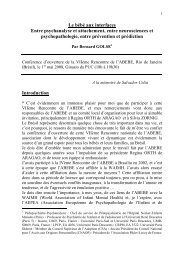Nouvelles normalités Nouvelles pathologies Nouvelles ... - Psynem
Nouvelles normalités Nouvelles pathologies Nouvelles ... - Psynem
Nouvelles normalités Nouvelles pathologies Nouvelles ... - Psynem
Create successful ePaper yourself
Turn your PDF publications into a flip-book with our unique Google optimized e-Paper software.
6° 6éme Congresso Congrès Européen Europeo de di Psicopatologia Psychopathologie dell’Infanzia de l’Enfance e et dell’Adolescenza<br />
de l’Adolescence<br />
Nuove <strong>Nouvelles</strong> normalità <strong>normalités</strong> Nuove <strong>Nouvelles</strong> patologie <strong>pathologies</strong> Nuove pratiche <strong>Nouvelles</strong> pratiques<br />
FRIDAY, May 6 POSTER SESSIONS<br />
Poster session 6 Interventions in different situations.<br />
Gli adolescenti problematici e la loro presa in carico<br />
5 - ROAD MAP OF THE TASKS & CHALLENGES OF ADOLESCENCE: A FAMILY AFFAIR<br />
Chantal Séjourné-Daitch Orange County Health Care Agency/ Children & Youth Services, (US)<br />
Adolescence is characterized by the transition<br />
from childhood to adulthood. During adolescence<br />
puberty takes place as well as a second<br />
separation-individuation from parental figures.<br />
Adolescence is often qualified as a “crisis”. In<br />
Chinese, the word crisis is spelled with two different<br />
characters. One means danger, and the<br />
other opportunity. Indeed, adolescence is the<br />
time when severe mental pathology emerges,<br />
but also is the time when youngsters become<br />
increasing independent and embrace interdependence.<br />
The tasks and challenges of adolescence<br />
are a family affair. The positive or negative<br />
outcome of adolescence is the result of the collaboration<br />
or the opposition between the different<br />
protagonists in a socio cultural context.<br />
THE CHALLENGE OF PUBERTY. In boys,<br />
puberty is marked by growth of the testicles and<br />
penis, the emergence of fertility, the apparition<br />
of pubic, body, and facial hair, voice changes,<br />
the increase of musculature, apparition of and<br />
android body shape, a rapid growth in stature,<br />
the apparition of stronger body odor and acne<br />
under the influence of increased secretion of testosterone.<br />
In girls, puberty is marked by breast<br />
development, growth of pubic and axillary hair,<br />
the maturation of the uterus, ovaries and vagina<br />
leading to the emergence of fertility and the apparition<br />
of leucorrhea and menarche, a rapid growth<br />
in stature with a curvy body shape, a stronger<br />
body odor and the apparition of acne. These<br />
physical changes are under the influence of both<br />
the estrogens and female androgens. Boys and<br />
girls, in order to enter school, are required to control<br />
their body functions. During their elementary<br />
school years, mastery and control are emphasized,<br />
and children learn by mimicking and imitating<br />
adults they idealize and strive to resemble.<br />
When puberty hits them, youngsters have to<br />
adjust and adapt to their body they may expe-<br />
323<br />
rience as foreign, strange, and out of control.<br />
The emergence of sexual urges and the beginning<br />
of menstruation are often anxiety provoking<br />
and experienced as embarrassing, even shameful<br />
due partly to their incontrollable nature. The<br />
procreative ability in adolescents is addressed in<br />
traditional patriarchal societies, in a quite different<br />
manner according to the gender. As a rule,<br />
patriarchal societies value female virginity, fidelity,<br />
and chastity to ensure that the off- springs of<br />
a married couple are, in fact, the husband’s children.<br />
On the other hand, sexual experiences are<br />
considered as desirable in young men and may<br />
earn them the “manly” epithet. The double standard<br />
attitude leads to confusion and anger in the<br />
youngsters, especially girls, and is anxiety provoking<br />
in their parents. Parents of adolescents<br />
fear mostly that their daughter will become pregnant<br />
out of wedlock, which is considered in traditional<br />
patriarchal societies as the “worse family<br />
shame”. Consequently,, “good parents”, in such<br />
societies, attempt to control and restrict their<br />
daughter’s sexuality to prevent such an occurrence<br />
and preserve their daughter’s virginity until<br />
marriage.<br />
THE CHALLENGE OF SEPARATION- INDI-<br />
VIDUATION. The separation individuation taking<br />
place during adolescence could be considered<br />
as a second episode, the first episode of this<br />
process, being called “the terrible twos”. During<br />
toddler hood, the first episode of the separation<br />
individuation process lasts a few months<br />
to about a year. On the other hand, the second<br />
episode of this process lasts for several years.<br />
The changes taking place during adolescence<br />
are comparable to a metamorphosis affecting,<br />
not only the youngsters, , but also their parents.<br />
During adolescence, the child who was respectful,<br />
invested in following the rules and seeing<br />
them respected by others, comes to question



